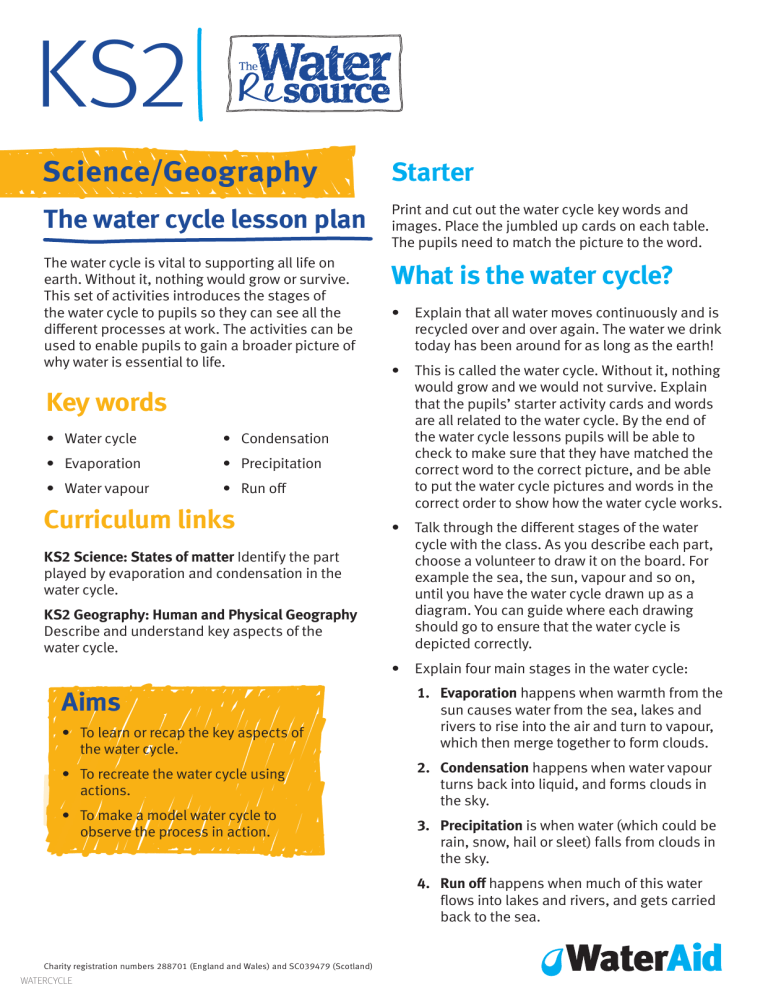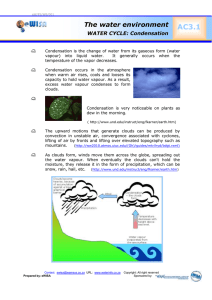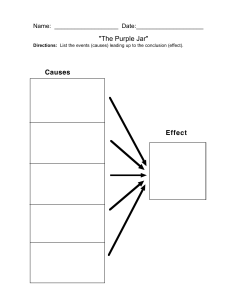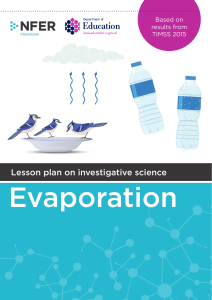
KS2 Science/Geography Starter The water cycle lesson plan Print and cut out the water cycle key words and images. Place the jumbled up cards on each table. The pupils need to match the picture to the word. The water cycle is vital to supporting all life on earth. Without it, nothing would grow or survive. This set of activities introduces the stages of the water cycle to pupils so they can see all the different processes at work. The activities can be used to enable pupils to gain a broader picture of why water is essential to life. What is the water cycle? Key words • Water cycle • Condensation • Evaporation • Precipitation • Water vapour • Run off Curriculum links KS2 Science: States of matter Identify the part played by evaporation and condensation in the water cycle. KS2 Geography: Human and Physical Geography Describe and understand key aspects of the water cycle. • Explain that all water moves continuously and is recycled over and over again. The water we drink today has been around for as long as the earth! • This is called the water cycle. Without it, nothing would grow and we would not survive. Explain that the pupils’ starter activity cards and words are all related to the water cycle. By the end of the water cycle lessons pupils will be able to check to make sure that they have matched the correct word to the correct picture, and be able to put the water cycle pictures and words in the correct order to show how the water cycle works. • Talk through the different stages of the water cycle with the class. As you describe each part, choose a volunteer to draw it on the board. For example the sea, the sun, vapour and so on, until you have the water cycle drawn up as a diagram. You can guide where each drawing should go to ensure that the water cycle is depicted correctly. • Explain four main stages in the water cycle: Aims • To learn or recap the key aspects of the water cycle. • To recreate the water cycle using actions. • To make a model water cycle to observe the process in action. 1. Evaporation happens when warmth from the sun causes water from the sea, lakes and rivers to rise into the air and turn to vapour, which then merge together to form clouds. 2. Condensation happens when water vapour turns back into liquid, and forms clouds in the sky. 3. Precipitation is when water (which could be rain, snow, hail or sleet) falls from clouds in the sky. 4. Run off happens when much of this water flows into lakes and rivers, and gets carried back to the sea. Charity registration numbers 288701 (England and Wales) and SC039479 (Scotland) WATERCYCLE Making a drama of the water cycle • Recap the main stages of the water cycle and what each of the following words mean: • Evaporation • Condensation • Precipitation • Run off • Explain to the class that they will be acting out the water cycle. Split the class into four groups. Each group should be allocated one stage of the water cycle. Make sure that the other groups don’t know what stage it is – you could write each stage on a card and put it in an envelope, so that other groups can’t see or hear what has been given to them. • Each group should then think of actions they could use to represent the stage. Once they have decided on their actions, they should share them with the rest of the class who have to guess what stage of the water cycle the group is representing. • Each group should then teach the action to the rest of the class to create a dramatised water cycle. Build a model water cycle Now that your pupils are all water cycle experts, explain that they are going to make their own models of the water cycle to see it in action. For the models, you will need the following for each child: • A clear plastic jar (they should label their jars so that they can observe and record what is happening) • Cling film or sheets of clear plastic • Rubber band • Soil • Birdseed • Measuring cup • Water Charity registration numbers 288701 (England and Wales) and SC039479 (Scotland) Go through the instructions below with your pupils: 1. Ensure that the plastic jar is clean and dry. 2. Add a layer of soil to the bottom of the jar. The layer should be about 2 cm deep. 3. Sprinkle about half a teaspoon of birdseed over the soil. 4. Cover the bird seed with another layer of soil that is also about 2 cm deep. 5. Measure 60 ml of water using the measuring cup. Slowly pour this over the soil. Make sure the water is poured evenly over the soil’s surface. 6. Cover the top of the jar with cling film or plastic and secure it with a rubber band. 7. Place the jars on a window sill or other place where they can remain in direct sunlight. Over the next few days, the pupils should examine their jars and record what they can see. They should then answer the following questions: 1. How did the appearance of the jar and plastic cover change? 2. Did droplets appear on the inside or outside of the jar? 3. Where do you think the droplets came from? 4. What happened to the birdseed? 5. What role did sunlight play in the change from liquid water to water vapour? Assessment Using their observations, the pupils should draw their jars and explain the processes using the correct key words from the water cycle. They should take time to think about what they have learned, then pair up with another pupil and share their ideas. They can then assess each other’s understanding of the key words and processes and amend if necessary through feedback. Plenary Print off water cycle quizzes for each pupil to complete. Share the answers as a class and review each stage of the water cycle. Use questions to ensure that the pupils understand why the water cycle is vital to life on earth. For example the fact that, without the water cycle, rain would not fall to enable plants and crops to grow. Water cycle starter cards Print and cut out the water cycle key words and images. On each table place the jumbled up cards. The pupils need to match the picture to the word. Run off Lake Evaporation Condensation Precipitation Charity registration numbers 288701 (England and Wales) and SC039479 (Scotland) Plenary true or false quiz Circle either true or false for each question. 1. When heat from the sun heats up the sea, it turns the water into vapour. True or false 2. Condensation creates rain. True or false 3. The wind blows the clouds over land and the clouds drop their water as rain, sleet or snow. True or false 4. Evaporation creates water vapour. True or false 5. Run off is the excess water that runs back into rivers and lakes. True or false Charity registration numbers 288701 (England and Wales) and SC039479 (Scotland)






